Compsoft Limited: Financial Analysis and Break-Even Point
VerifiedAdded on 2024/05/31
|8
|1369
|161
AI Summary
This report analyzes the financial performance of Compsoft Limited, a newly established computer services and repair business. It examines the company's added value, surplus funds, and cost percentages. The report also includes a break-even analysis, calculating the break-even point in liters of petrol sold and the margin of safety. The analysis provides insights into the company's financial health and potential areas for improvement.
Contribute Materials
Your contribution can guide someone’s learning journey. Share your
documents today.
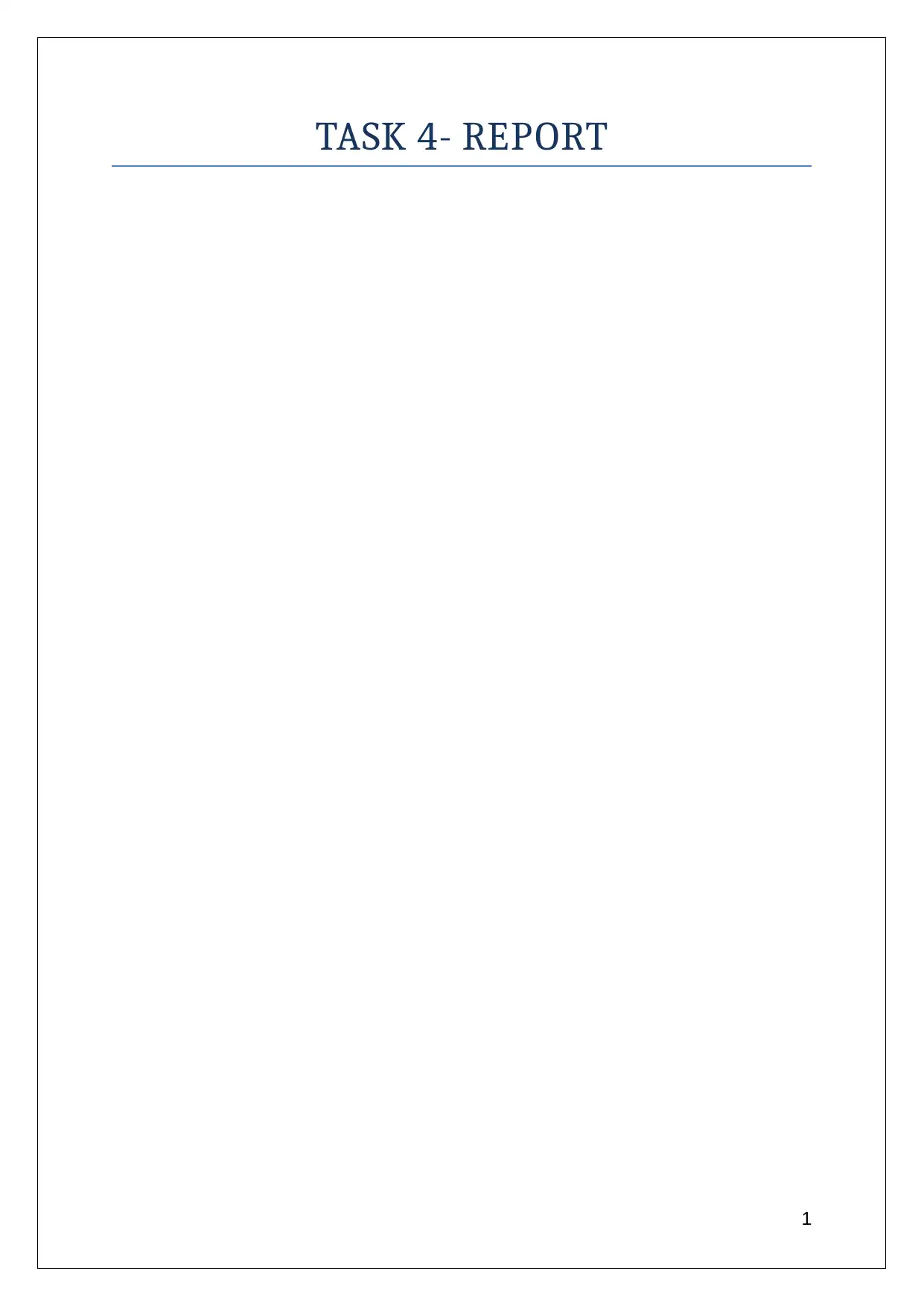
TASK 4- REPORT
1
1
Secure Best Marks with AI Grader
Need help grading? Try our AI Grader for instant feedback on your assignments.
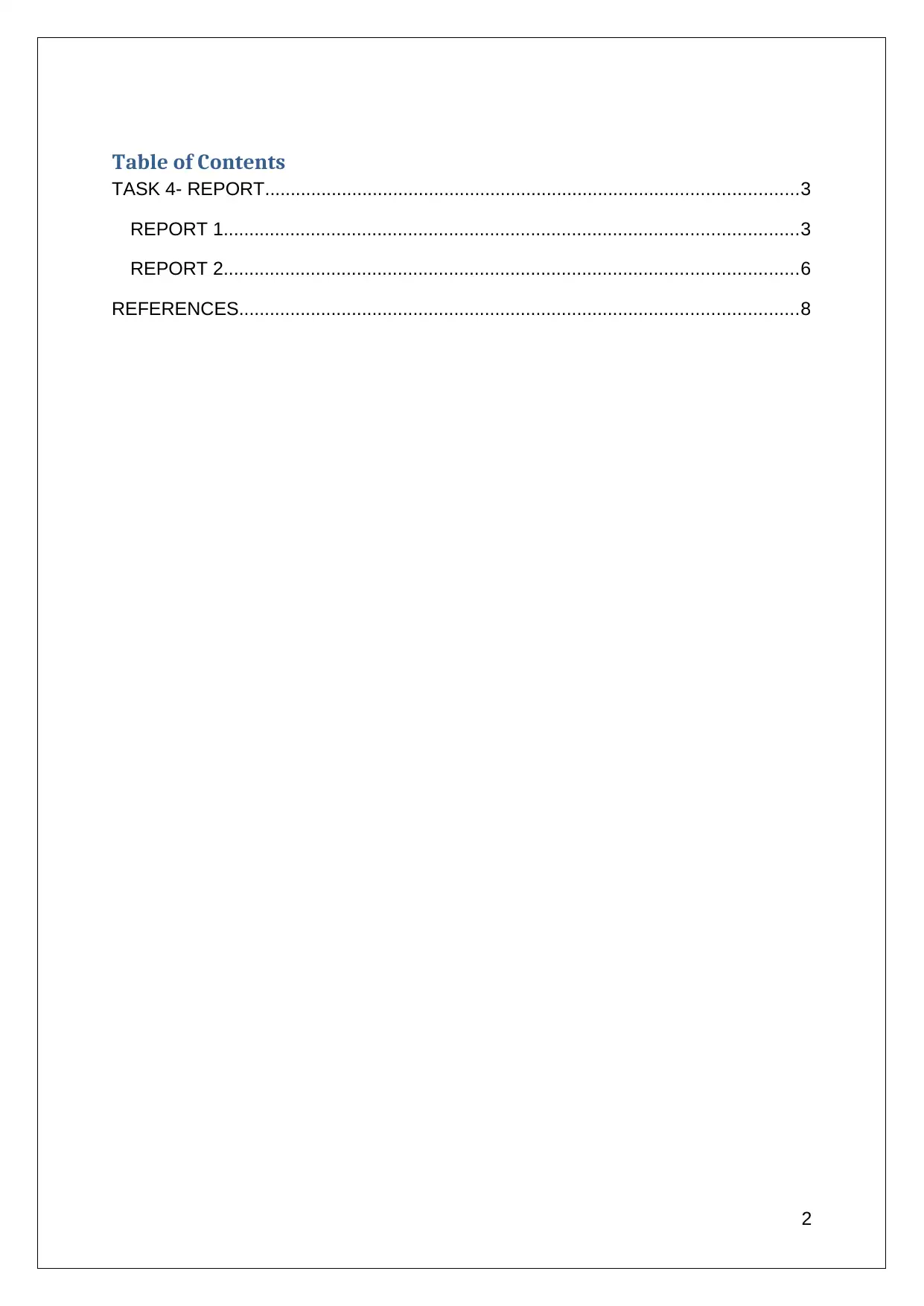
Table of Contents
TASK 4- REPORT........................................................................................................3
REPORT 1................................................................................................................3
REPORT 2................................................................................................................6
REFERENCES.............................................................................................................8
2
TASK 4- REPORT........................................................................................................3
REPORT 1................................................................................................................3
REPORT 2................................................................................................................6
REFERENCES.............................................................................................................8
2
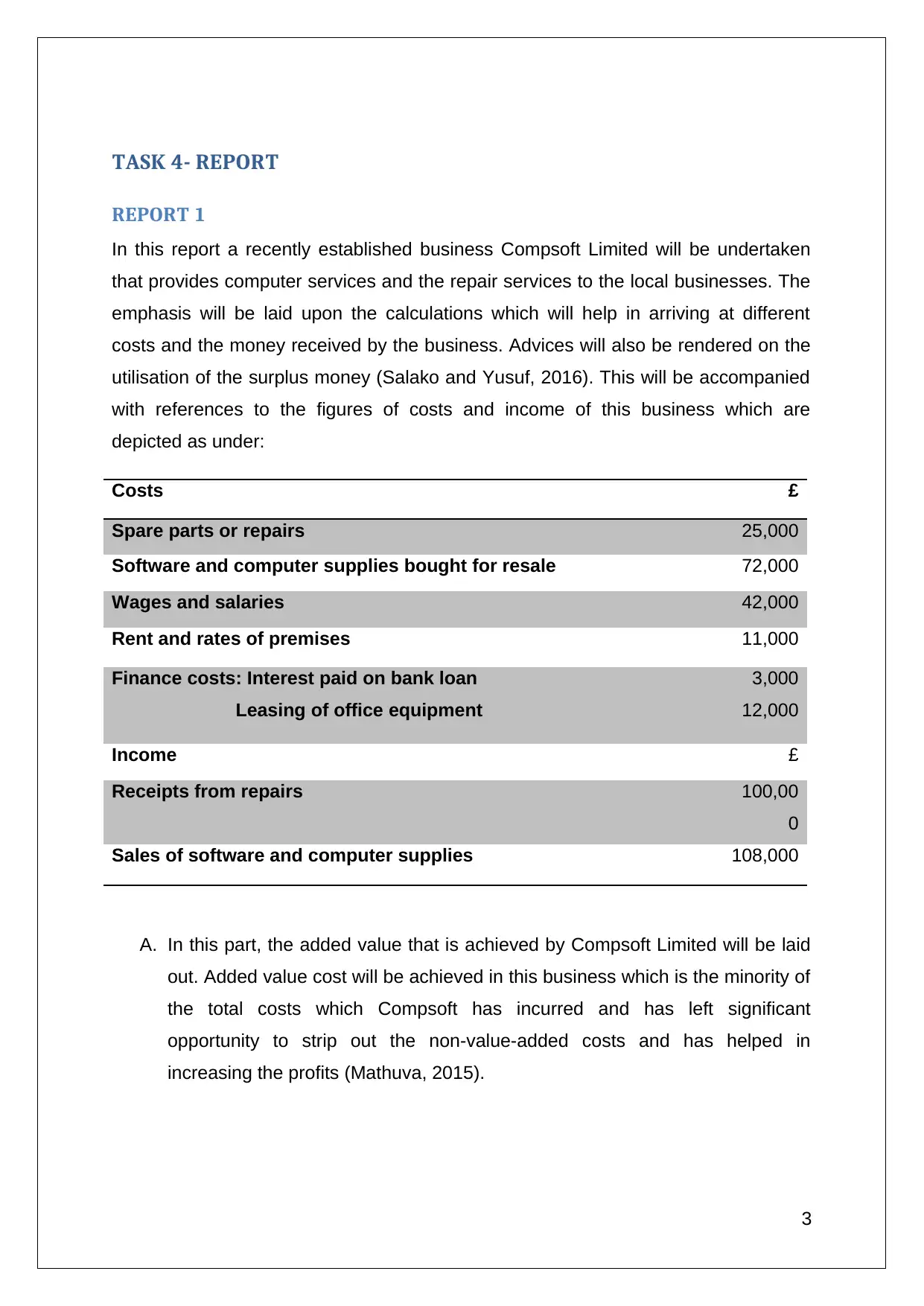
TASK 4- REPORT
REPORT 1
In this report a recently established business Compsoft Limited will be undertaken
that provides computer services and the repair services to the local businesses. The
emphasis will be laid upon the calculations which will help in arriving at different
costs and the money received by the business. Advices will also be rendered on the
utilisation of the surplus money (Salako and Yusuf, 2016). This will be accompanied
with references to the figures of costs and income of this business which are
depicted as under:
Costs £
Spare parts or repairs 25,000
Software and computer supplies bought for resale 72,000
Wages and salaries 42,000
Rent and rates of premises 11,000
Finance costs: Interest paid on bank loan
Leasing of office equipment
3,000
12,000
Income £
Receipts from repairs 100,00
0
Sales of software and computer supplies 108,000
A. In this part, the added value that is achieved by Compsoft Limited will be laid
out. Added value cost will be achieved in this business which is the minority of
the total costs which Compsoft has incurred and has left significant
opportunity to strip out the non-value-added costs and has helped in
increasing the profits (Mathuva, 2015).
3
REPORT 1
In this report a recently established business Compsoft Limited will be undertaken
that provides computer services and the repair services to the local businesses. The
emphasis will be laid upon the calculations which will help in arriving at different
costs and the money received by the business. Advices will also be rendered on the
utilisation of the surplus money (Salako and Yusuf, 2016). This will be accompanied
with references to the figures of costs and income of this business which are
depicted as under:
Costs £
Spare parts or repairs 25,000
Software and computer supplies bought for resale 72,000
Wages and salaries 42,000
Rent and rates of premises 11,000
Finance costs: Interest paid on bank loan
Leasing of office equipment
3,000
12,000
Income £
Receipts from repairs 100,00
0
Sales of software and computer supplies 108,000
A. In this part, the added value that is achieved by Compsoft Limited will be laid
out. Added value cost will be achieved in this business which is the minority of
the total costs which Compsoft has incurred and has left significant
opportunity to strip out the non-value-added costs and has helped in
increasing the profits (Mathuva, 2015).
3
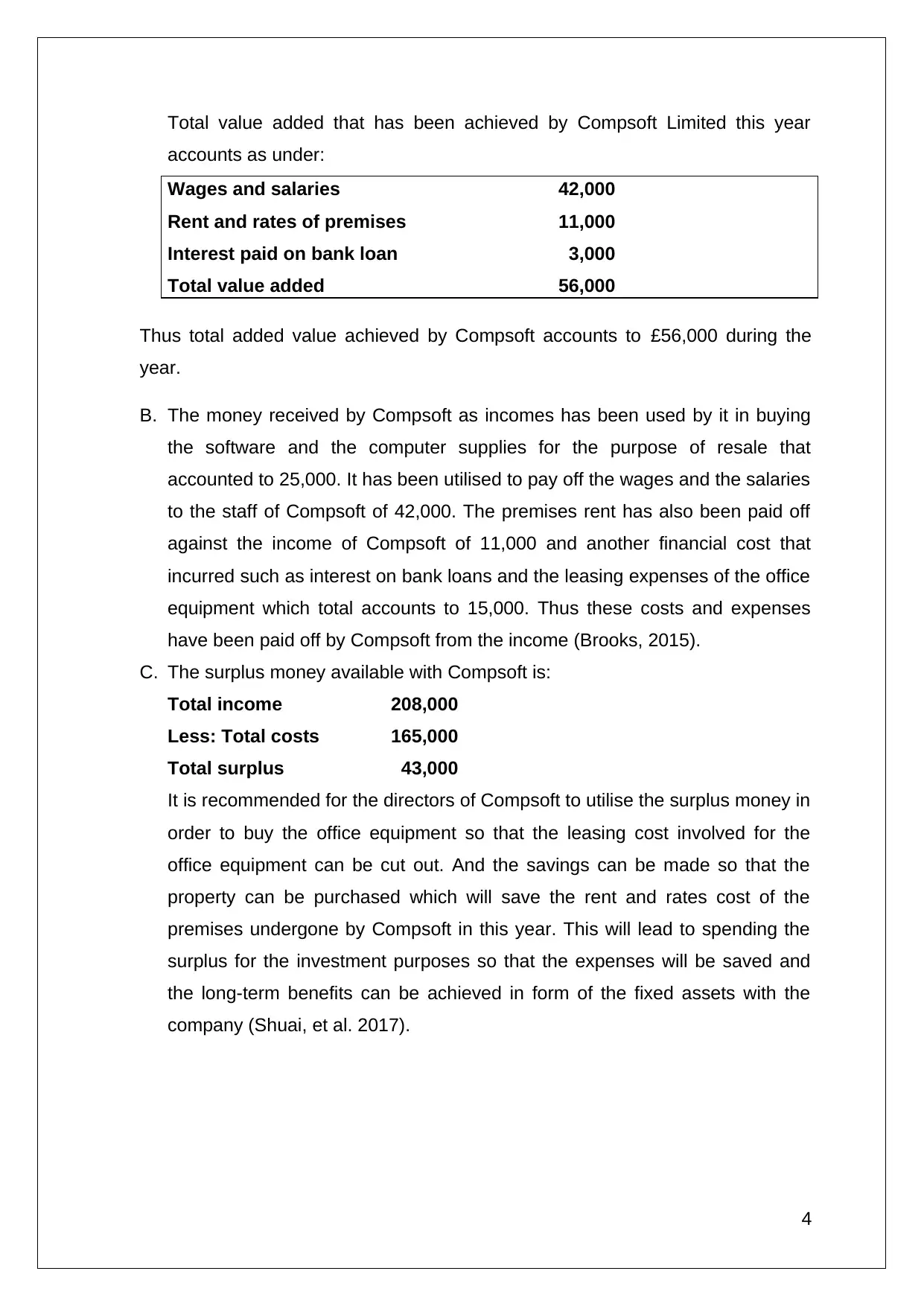
Total value added that has been achieved by Compsoft Limited this year
accounts as under:
Wages and salaries 42,000
Rent and rates of premises 11,000
Interest paid on bank loan 3,000
Total value added 56,000
Thus total added value achieved by Compsoft accounts to £56,000 during the
year.
B. The money received by Compsoft as incomes has been used by it in buying
the software and the computer supplies for the purpose of resale that
accounted to 25,000. It has been utilised to pay off the wages and the salaries
to the staff of Compsoft of 42,000. The premises rent has also been paid off
against the income of Compsoft of 11,000 and another financial cost that
incurred such as interest on bank loans and the leasing expenses of the office
equipment which total accounts to 15,000. Thus these costs and expenses
have been paid off by Compsoft from the income (Brooks, 2015).
C. The surplus money available with Compsoft is:
Total income 208,000
Less: Total costs 165,000
Total surplus 43,000
It is recommended for the directors of Compsoft to utilise the surplus money in
order to buy the office equipment so that the leasing cost involved for the
office equipment can be cut out. And the savings can be made so that the
property can be purchased which will save the rent and rates cost of the
premises undergone by Compsoft in this year. This will lead to spending the
surplus for the investment purposes so that the expenses will be saved and
the long-term benefits can be achieved in form of the fixed assets with the
company (Shuai, et al. 2017).
4
accounts as under:
Wages and salaries 42,000
Rent and rates of premises 11,000
Interest paid on bank loan 3,000
Total value added 56,000
Thus total added value achieved by Compsoft accounts to £56,000 during the
year.
B. The money received by Compsoft as incomes has been used by it in buying
the software and the computer supplies for the purpose of resale that
accounted to 25,000. It has been utilised to pay off the wages and the salaries
to the staff of Compsoft of 42,000. The premises rent has also been paid off
against the income of Compsoft of 11,000 and another financial cost that
incurred such as interest on bank loans and the leasing expenses of the office
equipment which total accounts to 15,000. Thus these costs and expenses
have been paid off by Compsoft from the income (Brooks, 2015).
C. The surplus money available with Compsoft is:
Total income 208,000
Less: Total costs 165,000
Total surplus 43,000
It is recommended for the directors of Compsoft to utilise the surplus money in
order to buy the office equipment so that the leasing cost involved for the
office equipment can be cut out. And the savings can be made so that the
property can be purchased which will save the rent and rates cost of the
premises undergone by Compsoft in this year. This will lead to spending the
surplus for the investment purposes so that the expenses will be saved and
the long-term benefits can be achieved in form of the fixed assets with the
company (Shuai, et al. 2017).
4
Secure Best Marks with AI Grader
Need help grading? Try our AI Grader for instant feedback on your assignments.
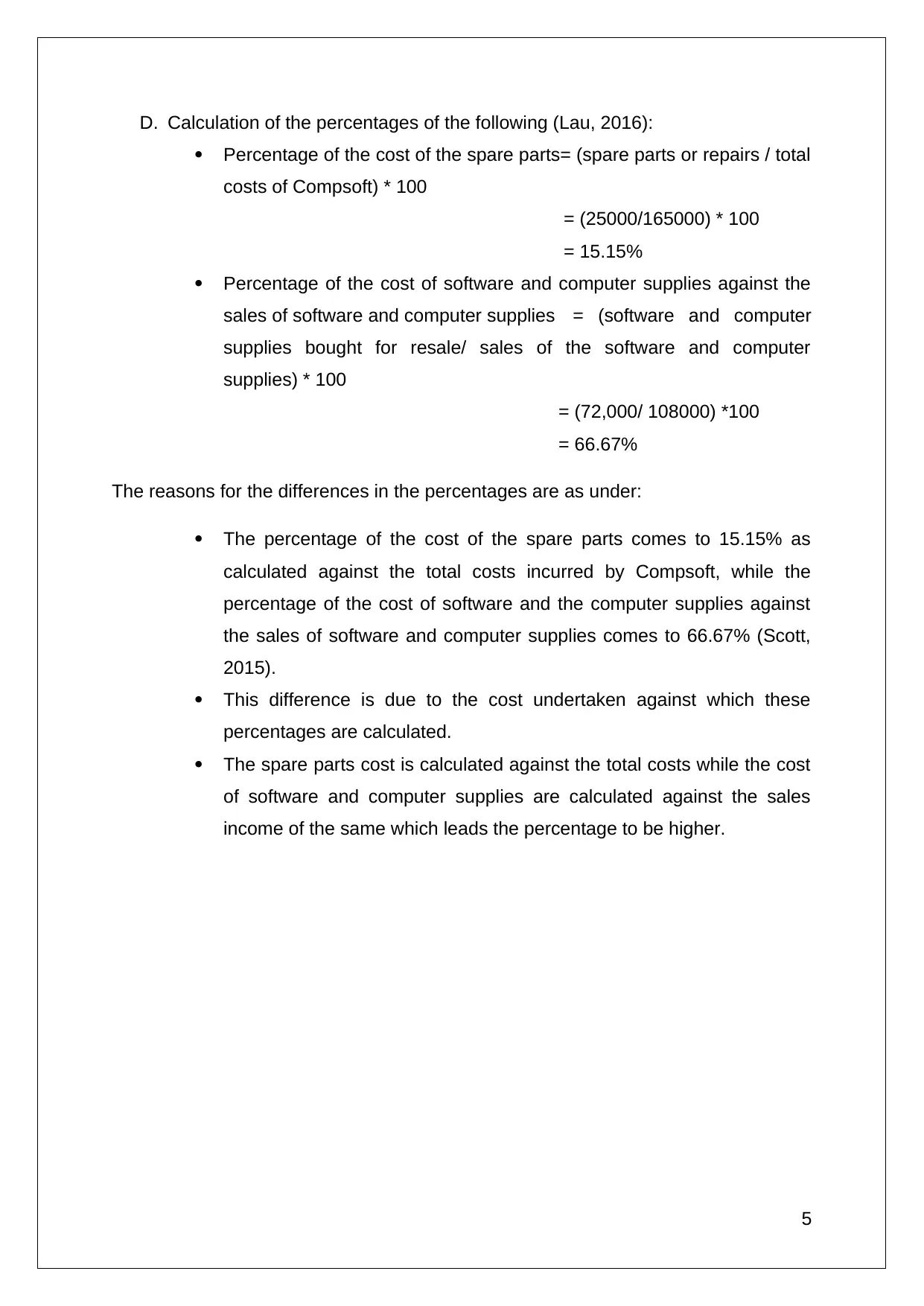
D. Calculation of the percentages of the following (Lau, 2016):
Percentage of the cost of the spare parts= (spare parts or repairs / total
costs of Compsoft) * 100
= (25000/165000) * 100
= 15.15%
Percentage of the cost of software and computer supplies against the
sales of software and computer supplies = (software and computer
supplies bought for resale/ sales of the software and computer
supplies) * 100
= (72,000/ 108000) *100
= 66.67%
The reasons for the differences in the percentages are as under:
The percentage of the cost of the spare parts comes to 15.15% as
calculated against the total costs incurred by Compsoft, while the
percentage of the cost of software and the computer supplies against
the sales of software and computer supplies comes to 66.67% (Scott,
2015).
This difference is due to the cost undertaken against which these
percentages are calculated.
The spare parts cost is calculated against the total costs while the cost
of software and computer supplies are calculated against the sales
income of the same which leads the percentage to be higher.
5
Percentage of the cost of the spare parts= (spare parts or repairs / total
costs of Compsoft) * 100
= (25000/165000) * 100
= 15.15%
Percentage of the cost of software and computer supplies against the
sales of software and computer supplies = (software and computer
supplies bought for resale/ sales of the software and computer
supplies) * 100
= (72,000/ 108000) *100
= 66.67%
The reasons for the differences in the percentages are as under:
The percentage of the cost of the spare parts comes to 15.15% as
calculated against the total costs incurred by Compsoft, while the
percentage of the cost of software and the computer supplies against
the sales of software and computer supplies comes to 66.67% (Scott,
2015).
This difference is due to the cost undertaken against which these
percentages are calculated.
The spare parts cost is calculated against the total costs while the cost
of software and computer supplies are calculated against the sales
income of the same which leads the percentage to be higher.
5
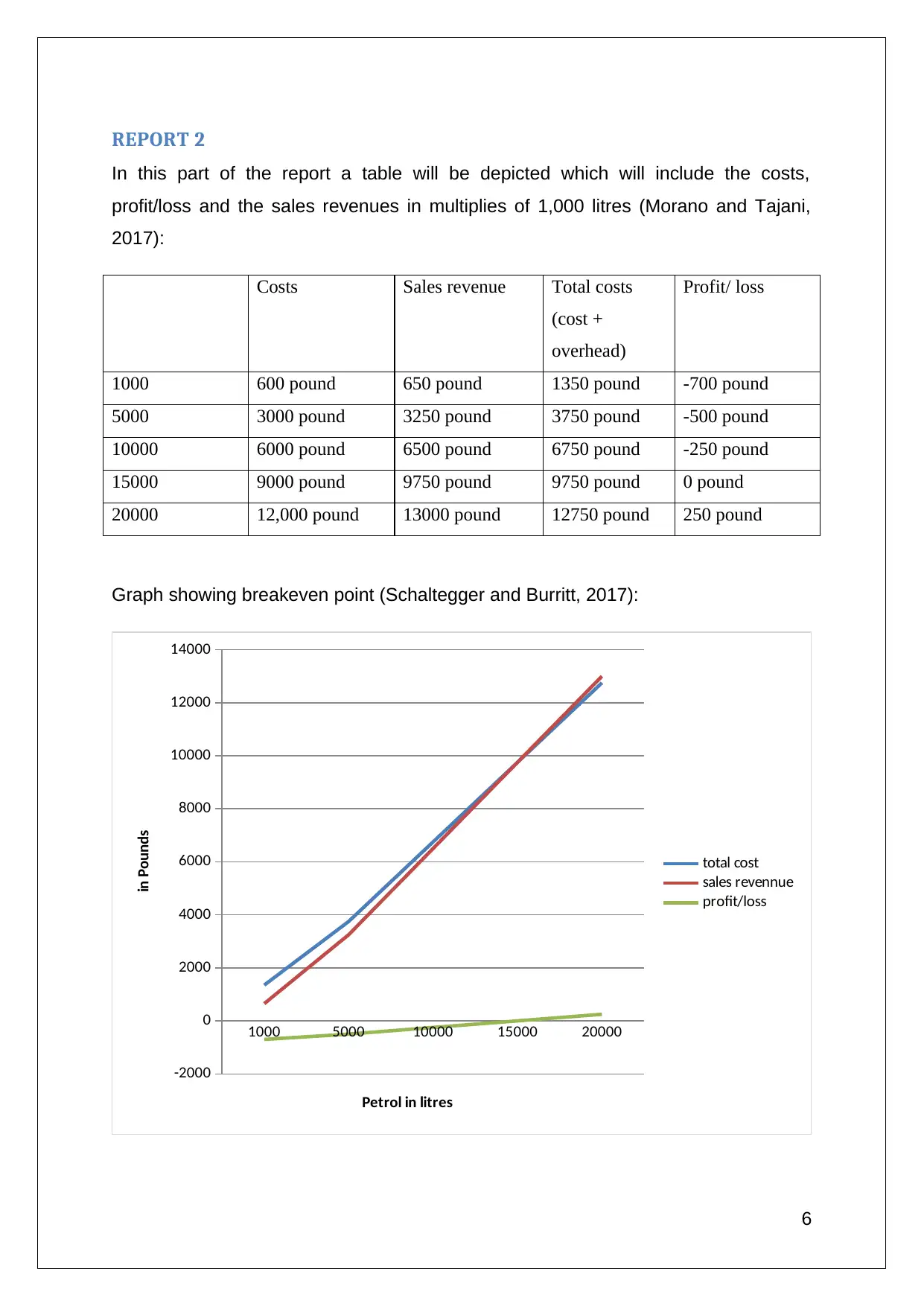
REPORT 2
In this part of the report a table will be depicted which will include the costs,
profit/loss and the sales revenues in multiplies of 1,000 litres (Morano and Tajani,
2017):
Costs Sales revenue Total costs
(cost +
overhead)
Profit/ loss
1000 600 pound 650 pound 1350 pound -700 pound
5000 3000 pound 3250 pound 3750 pound -500 pound
10000 6000 pound 6500 pound 6750 pound -250 pound
15000 9000 pound 9750 pound 9750 pound 0 pound
20000 12,000 pound 13000 pound 12750 pound 250 pound
Graph showing breakeven point (Schaltegger and Burritt, 2017):
1000 5000 10000 15000 20000
-2000
0
2000
4000
6000
8000
10000
12000
14000
total cost
sales revennue
profit/loss
Petrol in litres
in Pounds
6
In this part of the report a table will be depicted which will include the costs,
profit/loss and the sales revenues in multiplies of 1,000 litres (Morano and Tajani,
2017):
Costs Sales revenue Total costs
(cost +
overhead)
Profit/ loss
1000 600 pound 650 pound 1350 pound -700 pound
5000 3000 pound 3250 pound 3750 pound -500 pound
10000 6000 pound 6500 pound 6750 pound -250 pound
15000 9000 pound 9750 pound 9750 pound 0 pound
20000 12,000 pound 13000 pound 12750 pound 250 pound
Graph showing breakeven point (Schaltegger and Burritt, 2017):
1000 5000 10000 15000 20000
-2000
0
2000
4000
6000
8000
10000
12000
14000
total cost
sales revennue
profit/loss
Petrol in litres
in Pounds
6

The breakeven point is at 15000-litre points as there is no profit no loss and the
sales of petrol above 15000 litres will lead to profits (Titman, et al. 2017).
Break even point in litres = fixed costs / (sales price per unit – variable cost per unit)
= 750 / 0.65- 0.60
= 15000 litres
If 12000 and 18000 litres of petrol is sold each week than the loss in case of 12000
litres accounts for a loss of 150 pounds. While on another hand, the sale of 18000
litres of petrol will account for a profit of 150 pounds (Donnell, et al. 2016).
Litres Costs Sales revenue Total costs Profit/loss
12000 7200 7800 7950 -150
18000 10800 11700 11550 150
If sales are currently 18000 litres each week then the margin of safety will be:
The margin of safety = actual sales – breakeven point
= 18000 – 15000
= 3000 litres
Margin of safety (%) = {(current sales – breakeven point) / current sales level)} * 100
= {(18000- 15000)/ 18000)} * 100
= 16.67%
7
sales of petrol above 15000 litres will lead to profits (Titman, et al. 2017).
Break even point in litres = fixed costs / (sales price per unit – variable cost per unit)
= 750 / 0.65- 0.60
= 15000 litres
If 12000 and 18000 litres of petrol is sold each week than the loss in case of 12000
litres accounts for a loss of 150 pounds. While on another hand, the sale of 18000
litres of petrol will account for a profit of 150 pounds (Donnell, et al. 2016).
Litres Costs Sales revenue Total costs Profit/loss
12000 7200 7800 7950 -150
18000 10800 11700 11550 150
If sales are currently 18000 litres each week then the margin of safety will be:
The margin of safety = actual sales – breakeven point
= 18000 – 15000
= 3000 litres
Margin of safety (%) = {(current sales – breakeven point) / current sales level)} * 100
= {(18000- 15000)/ 18000)} * 100
= 16.67%
7
Paraphrase This Document
Need a fresh take? Get an instant paraphrase of this document with our AI Paraphraser
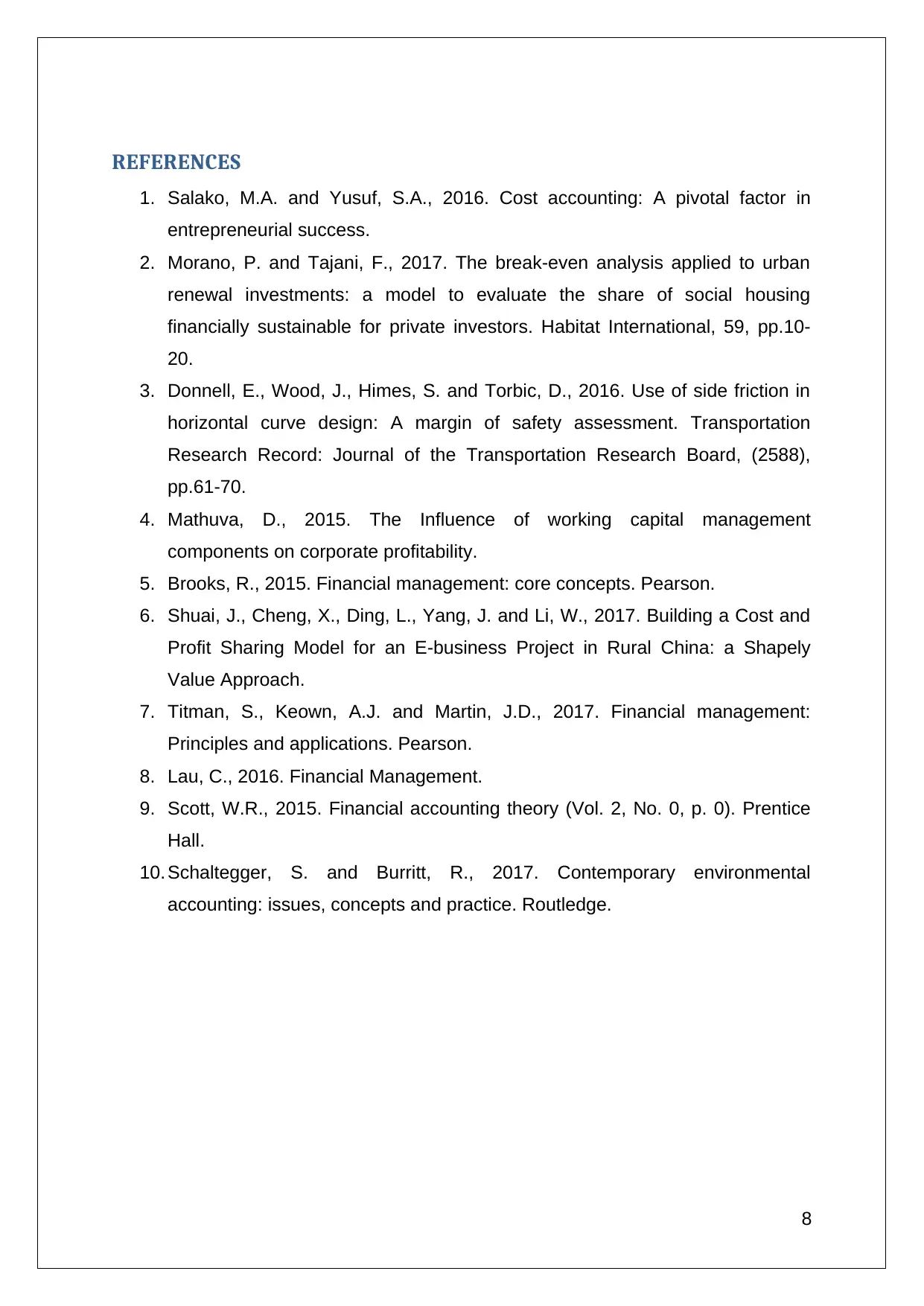
REFERENCES
1. Salako, M.A. and Yusuf, S.A., 2016. Cost accounting: A pivotal factor in
entrepreneurial success.
2. Morano, P. and Tajani, F., 2017. The break-even analysis applied to urban
renewal investments: a model to evaluate the share of social housing
financially sustainable for private investors. Habitat International, 59, pp.10-
20.
3. Donnell, E., Wood, J., Himes, S. and Torbic, D., 2016. Use of side friction in
horizontal curve design: A margin of safety assessment. Transportation
Research Record: Journal of the Transportation Research Board, (2588),
pp.61-70.
4. Mathuva, D., 2015. The Influence of working capital management
components on corporate profitability.
5. Brooks, R., 2015. Financial management: core concepts. Pearson.
6. Shuai, J., Cheng, X., Ding, L., Yang, J. and Li, W., 2017. Building a Cost and
Profit Sharing Model for an E-business Project in Rural China: a Shapely
Value Approach.
7. Titman, S., Keown, A.J. and Martin, J.D., 2017. Financial management:
Principles and applications. Pearson.
8. Lau, C., 2016. Financial Management.
9. Scott, W.R., 2015. Financial accounting theory (Vol. 2, No. 0, p. 0). Prentice
Hall.
10. Schaltegger, S. and Burritt, R., 2017. Contemporary environmental
accounting: issues, concepts and practice. Routledge.
8
1. Salako, M.A. and Yusuf, S.A., 2016. Cost accounting: A pivotal factor in
entrepreneurial success.
2. Morano, P. and Tajani, F., 2017. The break-even analysis applied to urban
renewal investments: a model to evaluate the share of social housing
financially sustainable for private investors. Habitat International, 59, pp.10-
20.
3. Donnell, E., Wood, J., Himes, S. and Torbic, D., 2016. Use of side friction in
horizontal curve design: A margin of safety assessment. Transportation
Research Record: Journal of the Transportation Research Board, (2588),
pp.61-70.
4. Mathuva, D., 2015. The Influence of working capital management
components on corporate profitability.
5. Brooks, R., 2015. Financial management: core concepts. Pearson.
6. Shuai, J., Cheng, X., Ding, L., Yang, J. and Li, W., 2017. Building a Cost and
Profit Sharing Model for an E-business Project in Rural China: a Shapely
Value Approach.
7. Titman, S., Keown, A.J. and Martin, J.D., 2017. Financial management:
Principles and applications. Pearson.
8. Lau, C., 2016. Financial Management.
9. Scott, W.R., 2015. Financial accounting theory (Vol. 2, No. 0, p. 0). Prentice
Hall.
10. Schaltegger, S. and Burritt, R., 2017. Contemporary environmental
accounting: issues, concepts and practice. Routledge.
8
1 out of 8
Related Documents
Your All-in-One AI-Powered Toolkit for Academic Success.
+13062052269
info@desklib.com
Available 24*7 on WhatsApp / Email
![[object Object]](/_next/static/media/star-bottom.7253800d.svg)
Unlock your academic potential
© 2024 | Zucol Services PVT LTD | All rights reserved.





